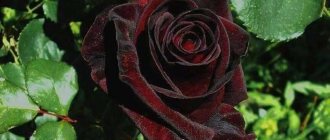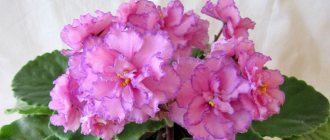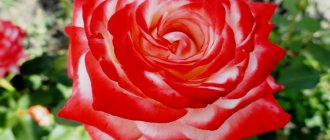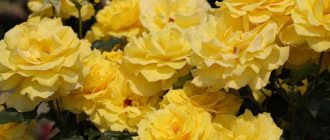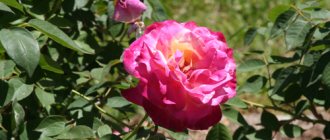Author of the article: Svetlana Golitsina | Updated: 12/19/2021
Did you know that some varieties of roses are named to emphasize how festive the atmosphere in the garden becomes when they appear? This is the name given to the Golden Celebration rose - a golden holiday, which is not surprising, because the flower harmoniously intertwines picturesque qualities and technical properties. Is it difficult to grow a plant in the garden, what advantages does it have and what crops does it combine with in the flowerbed? This is discussed in detail in the article.
Rose Golden Celebration
According to the description, the plant belongs to the English Austin roses. This famous group combines the characteristics of European roses and modern hybrid tea crops. In appearance, the plant is a bush rose - scrub.
The rose is characterized by large flowers of a rich shade.
The originator of the variety was the British company David Austin Roses. The rose was received in 1992. Then it was called AUSgold. To create the hybrid, popular varieties were used - Charles Austin and Abraham Darby.
Brief description, characteristics
The Golden Celebration rose is characterized by powerful bushes that reach 120-150 cm in height and width. The bushes have strong, slightly drooping shoots. In warm climates they can stretch out. In this case, the plant is grown as a climbing rose.
The shoots are covered with a moderate number of thorns. They are characterized by hard, dense leaves of a rich green color. They have a glossy shine.
The decorative properties of the culture are due to its stunning flowering. The flowers have a bright orange color. It also contains peach or rose notes. The result is large, golden-copper flowers. They reach a diameter of 14 cm.
Small brushes form on the bushes, which move slightly downwards under their own weight. Flowering is remontant. It is characterized by wave-like development. The strongest wave is observed at the beginning of summer.
Important! A characteristic feature of the culture is its amazing aroma. It is stable and contains sweetish-fruity notes.
Reproduction methods
The park rose Golden Celebration is usually propagated by cuttings. The diagram looks like this:
- After the first wave of flowering, several shoots are cut from a healthy bush.
- Shorten them to 12-15 cm and remove all leaves except a couple of plates.
- Dip the cuttings into a solution of a growth stimulator.
- After the roots appear, the shoots are planted in a nutrient substrate.
- The following year they are moved to a permanent place.
If the rose has flexible shoots, it can also be propagated by layering. One of the stems is bent to the ground, dug in and watered all summer, and separated from the bush in the fall or spring.
The Golden Celebration variety is not propagated by seeds, as it degenerates and loses its attractiveness
Advantages and disadvantages of the variety
Rose Golden Showers - climber characteristics
The Golden Celebration rose has many advantages. These include the following:
- densely double delicate inflorescences of copper-yellow color - this color is not typical for English roses;
- abundant flowering - it begins in early summer and lasts in waves until autumn;
- a powerful and strong bush - it is characterized by a rounded spreading crown;
- tall - if agrotechnical recommendations are followed, roses can reach 1.5-2 m;
- arcuate shoots with a moderate number of spines;
- shiny leaves of a bright green hue;
- high resistance to diseases.
The disadvantages of culture include the following:
- slightly reduced resistance to frost - in comparison with other English roses;
- intolerance to prolonged rains and excessive watering.
The indisputable advantage of the plant is considered to be powerful bushes.
Use in landscape design
English Rose Golden Celebration is often used to decorate areas.
It is used to create garden and park compositions. Moreover, the flower is placed in the very center, since it attracts maximum attention.
The plant is actively used to decorate the facades of houses, fences and arches.
A little about choosing planting material
Rose red naomi planting and care
In order not to make a mistake in choosing climbing roses, you need to purchase them in nurseries or greenhouses. Before you go shopping, you need to choose the right variety, taking into account:
- bush size;
- climatic conditions;
- soil;
- duration of flowering;
- resistance to diseases.
What you need to pay attention to
Seedlings are sold in pots, with an open root system or in a bag with substrate. If the roses are planted in the fall, you can purchase them with bare roots; if in the spring, then it is better to take seedlings in a container or in a substrate.
Before purchasing, you must carefully examine the root system and stems of the plant. They must be free of signs of rot, mold and dried areas. When purchasing a seedling in a bag, the soil should be crumbly and without any foreign odor. If the plant is sold in a pot, you need to look at the bottom, if white roots come out of the drainage holes, then this is the best material for planting.
The seedling must have healthy foliage, strong appearance and 2-3 shoots. Specimens with waxy foliage and bare stems are the first sign of a weak plant; such material will take a long time to take root and grow slowly.
Growing a flower, how to plant it correctly in open ground
Thuja Golden Globe - description
In order for the Celebration rose to develop well and bloom profusely, it needs to be provided with complete and high-quality care.
It is best to plant a plant on your site as seedlings. They can be purchased at a nursery or specialty store. You can also use cuttings for planting crops.
To plant a crop, you should choose a high-quality seedling
It is recommended to place seedlings in open soil in spring or autumn. Inexperienced gardeners are better off planting the plant in the spring. Over the summer it will have time to take root and get stronger. In the fall, the gardener may make a mistake with the planting time. This will lead to problems with acclimatization in the new place.
It is recommended to plant the rose in a place well protected from the wind. It is advisable to plant the bush in a well-lit area. This will help achieve abundant flowering.
How to prepare the soil and flower for planting
The site should be prepared in advance. It is best to do this in the fall. When digging up the soil, be sure to add manure or other organic fertilizers. The best options would be compost or humus. In the spring, the bed needs to be dug up again and minerals added.
Important! Too acidic soil is not suitable for roses. Therefore, before planting, add 1 cup of wood ash.
The root system of seedlings should be soaked in water or a special growth stimulator. This will facilitate the process of adaptation to new conditions.
Step by step landing procedure
To plant the Golden Celebration climbing rose, you need to do the following:
- Dig a hole measuring 40 cm.
- Cover the bottom of the hole with expanded clay.
- Sprinkle some soil on top.
- Place the seedling in the hole and cover it with soil.
- Compact the soil and water generously.
Specifics of cultivation and agrotechnical recommendations
Caring for Golden Celebration does not cause much trouble. The plant needs standard agricultural technology: regular watering (in dry, hot weather 2-3 times a week), loosening and mulching the soil, annual pruning and fertilizing (especially on infertile soils). Mineral and organic fertilizers are applied as needed - in the spring to stimulate growth (nitrogen), in the summer to maintain abundant flowering (potassium-phosphorus) and in the fall in preparation for the dormant period (phosphorus).
The bushes look impressive in single and group plantings; in mixborders they go well with sage, lavender, delphinium and other small-flowered perennials
To place seedlings purchased or prepared by cuttings on the site, you need to choose a well-lit and ventilated place without drafts or dampness. Planting in open ground is carried out in the spring. Experts recommend preparing a small hole in advance by adding manure or compost to the dug up soil in the fall, and before planting, covering the bottom of the hole with a drainage layer of expanded clay, crushed stone or coarse sand.
The variety is quite winter-hardy, but in most regions of Russia it can freeze slightly, so it requires shelter for the winter with preliminary pruning of immature shoots. The plant tolerates heat well, but reacts negatively to too intense watering and prolonged rains. Despite the high resistance to common crop diseases, it is advisable to carry out preventive treatments, especially when the bushes are dense.
Experienced gardeners grow the variety in standard and container culture using more intensive agricultural technology
Plant care
In order for the plant to fully develop and enjoy lush flowering for as long as possible, it needs to be provided with high-quality care.
Watering rules and humidity
Thuja Golden Smaragd - description
It is recommended to water the flower 2 times a week. If there is a lot of precipitation, you can moisten the soil less often.
For 1 bush you should use 10 liters of water. It is advisable to use clean and warm water.
Attention! After watering, it is advisable to loosen the soil and cover it with a mulch layer. Peat and sawdust are used for this.
Fertilizing and soil quality
Fertilizers should be applied several times during the season. In spring it is better to use mineral fertilizers containing nitrogen. This substance ensures active growth of green mass. When the first buds appear, it is worth using preparations based on phosphorus and potassium.
Important! During the flowering period, nitrogen products should be excluded. Otherwise, active growth of stems and leaves will be observed.
When the flowers bloom, it is necessary to re-apply fertilizers based on potassium and phosphorus. After flowering is completed, before the arrival of cold weather, superphosphate and potassium salt are used.
Pruning and replanting
Before the appearance of young leaves, it is worth carrying out sanitary pruning. During the procedure, it is recommended to get rid of damaged, diseased, dry and frozen stems. This procedure helps to enhance the development of the bush.
In summer, you need to remove excess shoots that are directed inside the bush. It is also necessary to get rid of faded buds. If necessary, autumn pruning can be carried out.
During pruning, dry and damaged branches are removed
Rose Celebration should not grow in one place for more than 10 years. Therefore, after the specified period, a rejuvenating transplant is performed. It is carried out by transshipment. This helps avoid damage to the roots.
Features of wintering a flower
The plant must be covered for the winter. To do this, in the fall the bushes must be trimmed and covered with earth. They need to be sprinkled with dry leaves and spruce branches on top.
Features of agricultural technology
The variety does not like shade, but even in the sun its petals easily fade. It is advisable to choose a place where sunlight falls only in the first half of the day or evening, and the rest of the time the bushes are in the shade of trees, fences or buildings.
The site must be protected from strong winds; drafts are also harmful. It is also recommended to plant bushes, avoiding too dense plantings.
The variety does not like shade or active sun.
Landing rules
Prepare the chosen place in advance. To do this, dig up the soil in the fall, always adding manure or other organic fertilizer - compost, humus. In the spring, they dig up again, fertilizing with complex mineral compounds. If the acidity level is high, mix 1 cup of wood ash into the soil before planting.
You can plant roses in open ground in spring and autumn. Beginners are recommended to plant in the spring to allow the seedlings to take root and grow stronger over the summer. If you do not guess the time of planting in the fall, the crop will not have time to acclimatize and will die in the winter.
For spring planting, choose the second ten days of May. Perform according to the scheme:
- dig planting holes 40 cm deep so that the roots grow faster, going deeper into the soil;
- when burying a seedling, make sure that the root collar is buried no more than 3 cm, otherwise the bush will degenerate into a rose hip and flowering will not occur;
- The soil at the planting site is carefully compacted - the seedling must not be allowed to wobble, as this will harm rooting.
At the end of planting, the soil is well moistened
Subtleties of care
Rose bushes have to be carefully monitored; the abundance of flowering depends on this. If the rules of agricultural technology are not followed, buds may not appear on the shoots at all.
Let's consider the basic care requirements:
- Water according to the schedule. On cloudy days, the bushes are irrigated twice a week, on hot days - more often, so that the bush does not dry out, in rainy weather - less often or stop altogether. Young bushes require 7–8 liters of water, adults require twice as much.
- Loosening the soil, removing weeds. Carry out the procedure after each watering or heavy rainfall. Once completed, the tree trunk circle is mulched with humus, sawdust or mowed grass.
- Regular fertilization. Performed several times per season. In spring, mineral nitrogen-containing fertilizers are needed to promote the active growth of green mass. By the beginning of budding, fertilizers with phosphorus and potassium will be needed (nitrogen ones are excluded). During the growing season the process is repeated. When the bushes fade, in late autumn the soil is fed with superphosphates and potassium salt.
- Sanitary pruning of shoots. Performed in spring and after flowering (if necessary). Dry branches, damaged or frozen, are cut off. At the same time, they get rid of the fading buds and thin out the crown of the bush somewhat.
Proper pruning of rose shoots
According to information from the US Department of Agriculture, the described crop is suitable for planting in zones 5 to 10. But there is a risk that already at –18 °C the bush begins to clearly freeze.
We invite you to read: I share my experience of how I plant roses in the fall
When planting in the central regions of our country, with the arrival of winter, the plant must be covered with spruce branches. However, there is no need to rush into shelter; cold temperatures down to –7 °C do not harm the bushes, but, on the contrary, harden them, preparing them for winter.
Author's advice
Before sheltering, the shoots are cut off, and the root area is covered with additional soil, compost or humus. It is undesirable to use peat and sawdust - they absorb moisture and provoke diseases during temperature fluctuations.
It is recommended to build a frame over the bushes and cover it with polyethylene, leaving areas on the sides for ventilation. But already from March-April the roses begin to ventilate.
According to the United States Department of Agriculture (USDA), Golden Celebration can grow in zones 5 through 10, although there is plenty of evidence that its shoots begin to noticeably freeze at -18°. In any case, in Central Russia the rose must be covered for the winter.
Resistance to common diseases is good, with the exception of black spot. For this reason, bushes should be planted in a well-ventilated, sufficiently lit area, avoiding thickening.
Rose blossom
The culture has a long flowering period. In this case, buds may appear on the bushes several times during the season.
The first flowers bloom in early July. In this case, flowering lasts until mid-October. In August or September the second wave of flowering begins. Usually it is not as abundant and lush as the first one.
Care during and after flowering
During the flowering period, it is necessary to reduce the amount of fertilizing. In this case, fertilizers should be applied only once.
It is recommended to use products based on potassium and phosphorus.
With proper care, the rose blooms profusely
What to do if it doesn’t bloom, possible reasons
The lack of flowering may be due to the following factors:
- insufficient watering;
- incorrect choice of landing site;
- mineral deficiency;
- development of diseases.
Preparations for feeding climbing roses
Roses are fed twice: at the beginning of the growing season and during flowering. Usually microelements are added in combination with a solution of complete mineral fertilizer or with organic nutrition: slurry.
Microelements are used as foliar feeding, sprayed “on the sheet”. It is carried out in the evening hours so that the droplets with useful substances do not evaporate, but are absorbed into the leaves.
Of the ready-made fertilizers, we can recommend
- “Strawberry concentrate” containing nitrogen, phosphorus and potassium as a spring supplement,
- mineral fertilizer “Autumn” in granules is applied during the flowering period,
- fertilizers for indoor flowers as foliar feeding.
Climbing Golden roses are exquisite, unusual and look exotic. But if you managed to grow this miracle flower, then the garden plot will take on new colors, a new style and will look different. The main thing is to correctly place color accents. The main thing is to take good care of the crop, caring for it and preventing it from freezing in winter.
How beautiful climbing roses look, entwining fences, a gazebo, and the walls of a house. They are very popular among landscape design lovers because of their beauty and ability to combine with different styles. Climbing roses on arches will give your summer cottage a bewitching appearance and a romantic mood.
Diseases, pests and ways to combat them
The plant practically does not suffer from fungal infections. Sometimes it encounters black spot. In such a situation, the bush should be treated with fungicides.
The most common pests found are aphids or spider mites. If the lesion is small, they can be collected manually. If the problem is widespread, then it’s time to use systemic insecticides, which can be found in garden stores.
Rose Golden Celebration by David Austin has excellent decorative characteristics. It is often used in landscape design, surprising the uncharacteristic color of the buds. To achieve success in growing a crop, it requires quality care.
Possibility of use
The park rose Golden Celebration attracts attention due to its resemblance to the sun. It is better to plant it as a tapeworm, since the plant outshines its neighbors. Pink plantings look great at the central gate and at the entrance, in urban central flower beds and small open garden lawns.
Park culture is often used to decorate high arches, building walls, and fences. You can also purchase a container version, but then timely pruning will be required.
Growing in a flower pot Growing on a trunk Rose garden in the garden Monoflower Flower bed Decorating garden paths
First of all, this is a main rose, capable of attracting attention with its sunny, bright appearance. As a tapeworm plant, it is unrivaled! Looks great near the central gate, at the entrance to the house, on a small open lawn.
As already mentioned, it is often (especially in southern countries) used to decorate high arches, walls of buildings, fences - as a climbing rose. It is often sold as a container specimen, but in this case it requires timely pruning.
It is difficult to find a person who would be dissatisfied with the Golden Celebration rose, having once planted it on his plot! After all, you must admit, everything about her, like a real queen, is beautiful!
Appearance
Although this variety of roses is classified as a bush variety, in warm climates and in favorable conditions it is capable of climbing. If the height of the scrub reaches 120-150 cm, then the arched shoots can grow up to 2 m. The hybrid inherited such plasticity from one of its ancestors - the climbing American climber Aloha.
The bush itself is powerful, beautiful and compact - it has almost the same dimensions, both in height and in width. The dense, glossy leaves located on arched shoots are rigid, and the color is green and rich. There are few thorns.
The beauty of this rose is fully revealed during its flowering. The combination of an ancient cup-shaped shape with an unusual color (honey-yellow) is perceived very harmoniously; the impressive size of the flowers is also surprising: 8-14 cm.
The color effect is created by small pink dots scattered on a yellow background. The buds are also large and open gradually, so the rose blooms almost the entire season. Flowering begins already in June, repeated waves quickly replace each other until the cold weather.
The aroma is also incomparable: sweet and rich, at the same time, it is not at all aggressive, and this enchanting smell penetrates every corner of the garden, evoking a romantic mood. You can detect tea, honey, and even lemon notes in it.
Additional benefits of the variety
- Repairability – repeated flowering.
- Fast growth.
- Beautiful cluster arrangement of inflorescences.
- Plastic.
- Resistance to diseases characteristic of roses.
The disadvantage is that the flowers are not resistant to rain, although this variety is successfully grown in areas with cool and damp summers, for example, in the Kaliningrad region.
Expert advice on growing English roses in climbing form
In expert A. Stepanov’s own garden, the Golden Celebration rose easily surpassed the 2-meter “bar.”
The well-known Russian expert in the field of rose growing, a regular author of the Gardener's Bulletin magazine, Alexey Stepanov, in his articles about English roses, pays a lot of attention to their cultivation in climbing form. In particular, he writes:
“Large varieties, in the pedigree of which there are climbing roses, can be grown in our climate in a climbing form in the form of climbers, and they will bloom along the entire length of the shoots... Most English roses bloom along the entire length of the shoots, and this is what appeals to me in contrast from some other climbing roses."
To grow an English rose with a whip, Alexey Stepanov advises doing this:
- choose the strongest ones from annual shoots;
- remove side branches from them, if any;
- cut weak basal shoots to the base;
- Selected shoots, without pruning, should be preserved along their entire length in winter.
Next season, these lashes need to be given the opportunity to grow further. If their growth is not limited by pruning, they will grow as much as their genetic potential allows.
However, according to A. Stepanov, “it is quite difficult to grow a climbing form from some varieties in our climate. Over time, the lashes of such roses lose flexibility, becoming very rigid, therefore, bending them is already problematic. Having cut such a rose short for cover at least once, the opportunity to get a climbing form is immediately pushed forward for several years, until all the short-cut shoots are cut out and new long ones grow.”
Care Tips
The rose can be shaped as a climbing vine or bush form.
It all depends on your desire and imagination. Golden Showers is one of the most popular climbing roses with yellow flowers. Since 1985, when this variety was bred, until today, the demand for it has remained consistently high. The plant is unpretentious (in the southern regions) and decorates the garden from May to October.
Key points related to care:
- An ornamental plant needs free space and an open, sunny place. Tolerates partial shade, but should be lit up to 6 hours a day.
- Loves fertile and nutritious soils without stagnant moisture. The planting site must have good drainage.
- The area for planting is 2x3 m in size, protected from drafts and winds.
- The Golden flower crop can be planted both in spring and in autumn. Place a trellis right next to it and secure the plant so that it does not spread along the ground. The seedling is placed in the ground with compost at a slight angle.
- For the winter, the exotic beauty should be covered by placing the lashes in the grooves, wrapping them in straw, spruce branches, and burlap. In the spring, release after the snow melts, removing old and diseased shoots.
- Before flowering, the rose needs to be fed, wilted flowers cut off, watered, mulched, and tied up.
The Golden Showers variety is disease resistant, but sometimes suffers from powdery mildew. Winters in the Moscow region, but more often in bush form. The variety has not yet spread further north due to cold winters, although it is not afraid of damp and cool summers.




